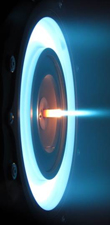All systems go for electric propulsion technologies
Given the particular environment of space - extreme temperatures, vacuum, radiations, etc.- its exploration calls for various basic 'building blocks' to be in place. These include reliable and cost-effective access to space from Earth, robust spacecraft, shielding from cosmic rays and solar flares, power generation, and efficient and reliable propulsion systems. 'High power electric propulsion: A roadmap for the future' (HIPER) project aimed to address the last two points as it worked to conceive a roadmap for future space exploration and transportation. These activities stand to benefit from technological advancements in electric propulsion (EP) technologies as well as from related advancements in power generation in space. HIPER interdisciplinary team, comprising 20 partners from 6 EU countries, brought together specialists in EP and power generation in space. With the backing of existing know-how and expertise, project partners chose to focus only on three different EP systems and related high-power generation. This decision was also justifiedby the intrinsic advantages of EP technology as compared with traditional chemical propulsion (i.e. rocket engines). State-of-the-art specific impulse capabilities and related overall efficiency are at least an order of magnitude higher for EP systems than for chemical propulsion. This means that by using EP huge propellant savings can be achieved. On the other hand, chemical propulsion requires less electric power than EP and performs better in terms of thrust and transfer-time. HIPER aimed at bridging that gaps, and at making EP systems more and more appealing for any kind of space mission. The division of project work into five main areas covered mission analysis, propulsion system requirements and recommendations; in-space power generation; high-power Hall effect thruster development; high-power gridded ion engine development; and development of a magnetoplasmadynamic thruster (MPDT). Beyond technological advances, the project team also considered major technological efforts in the framework of political and social scenarios, in relation to both European states and non-European partners. As such, discussions and meetings were held with National Aeronautics and Space Administration (NASA) and other major American organisations to share project results and harmonise future roadmaps. This is a matter of strategic importance. As a result, a large group of research centres, universities, private companies and enterprises came together for the first time to actively discuss steps that need to be taken to define a roadmap for the future development and exploitation of high-power EP. Project efforts proved highly successful, leading to fruitful cooperation among all partners involved. HIPER approach promises to pave the way for successful and widespread usage of high-power EP in space. From an economic perspective, high-power EP applications will greatly reduce the overall mission cost, both of access to space by strongly reducing propellant consumption for near-Earth orbit (NEO) transfer, interplanetary travels, orbit raising, and spacecraft orbit control.



